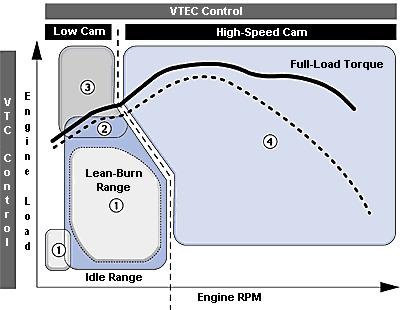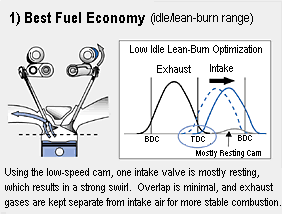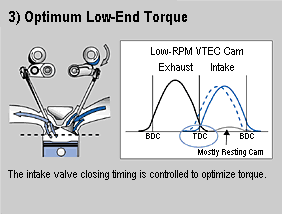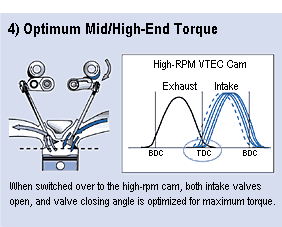|
Master EcoModder
Join Date: Dec 2011
Location: New Zealand
Posts: 5,142
Thanks: 2,930
Thanked 2,604 Times in 1,619 Posts
|
Thought I'd share one of my favorite articles, which I'll be using to aide in tuning this engine:
Honda's K20A Engine
Quote:
An Imagery of the i-VTEC Implementation





EGR Effect: By swirling back some of the exhaust air back into the combustion chamber, combustion temperature is lowered, and NOx output is reduced.
~
The iVTEC operating principle
This section is the most complex of the whole article. As explained by Honda, we need to look at the operating combinations in a 3D mode now since we have introduced variable valve opening overlap in addition to the two stage cam profiles. Honda identifies 4 major cam variations for the K20A's iVTEC implementation. Of these, variations 1 to 3 are based on the so-called low cams and only variation 4 uses the high-cams. Note that the diagrams shows that VTEC is implemented only on the intake cam.
Now, note that there is an annotation indicating a 'mostly resting (intake) cam' in variations 1 to 3. This is the 'approximately 1-valve' operating principle of VTEC-E. Ie, one intake valve is hardly driven while the other opens in its full glory. This instills a swirl effect on the air-flow which helps in air-fuel mixture and allows the use of the crazy 20+ to 1 air-to-fuel ratio in lean-burn or economy mode during idle running conditions.
On first acquaintance, variations 1 and 3 seems identical. However, in reality they represent two different engine configurations - electronic-wise. Variation 1 is lean burn mode, the state in which the ECU uses >20:1 air-fuel ratio. VTC closes the intake/exhaust valve overlap to a minimal. Note that lean-burn mode or variation 1 is used only for very light throttle operations as identified by the full load Torque curve overlaid on the VTC/RPM graph. During heavy throttle runs, the ECU goes into variation 3.
Lean-burn mode is contained within variation-2 as a dotted area probably for the reason that the ECU bounces to-and-fro between the two modes depending on engine rpm, throttle pressure and engine load, just like the 3-stage VTEC D15B and D17A. In variation-2, the ECU pops out of lean-burn mode, goes back to 14.7 or 12 to 1 air-fuel ratios and brings the intake/exhaust overlap right up to maximum. This as Honda explains will induce the EGR effect, which makes use of exhaust gases to reduce emissions. I believe this is somewhat similar to the principle used in CVCC that Honda introduced on their early generation Civics in order to meet emissions objectives in the early 1970s.
I believe variation-3 is the mode where the ECU varies intake/exhaust opening overlap dynamically based on engine rpm for heavy throttle runs but low engine revs. Note also that variations 1 to 3 are used in what Honda loosely terms the idle rpm. For 3-stage VTEC engines, idle rpms takes on a much broader meaning. It is no longer the steady 750rpm or so for an engine at rest. For 3-stage VTEC, idle rpm also means low running rpm during ideal operating conditions, ie closed or very narrow throttle positions, flat even roads, steady speed, etc. It is an idle rpm range. The K20A engine implements this as well.
Variation-4 is activated whenever rpm rises and throttle pressure increases, indicating a sense of urgency as conveyed by the driver's right foot. This mode sees the wild(er) cams of the intake camshaft being activated, the engine goes into 16-valve mode now and VTC dynamically varies the intake camshaft to provide optimum intake/exhaust valve overlap for power.
|
|